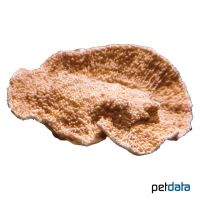Red Stone Coral (LPS) (Echinophyllia echinoporoides)
| Red Stone Coral (LPS) Echinophyllia echinoporoides | |
|---|---|
| Name | Red Stone Coral (LPS) |
| Name Lat. | Echinophyllia echinoporoides |
| Family | Brain Corals |
| Family lat. | Lobophylliidae |
| Order | Stony Corals |
| Order lat. | Scleractinia |
| Origin | Western Pacific |
| Diet | Planktivore, autotrophic |
| pH | 8.1-8.4 |
| Hardness | 8-10 °KH |
| Lighting | Medium-high |
| Current | Moderate |
| Behavior | Aggressive |
| Keeping | Colony |
| Care Level | Moderate |
| Life Span | N/A |
| Protection | CITES Appendix II; EC Annex B |
| Metric Units | |
| Size | < 30 cm |
| Temperature | 24-27 °C |
| Salinity | 33-36 ‰ |
| Aquarium | 200 l |
| US Units | |
| Size | < 12" |
| Temperature | 75-81 °F |
| Salinity | 1.020-1.025 sg |
| Aquarium | 50 gal |
Distribution and habitat
Echinophyllia echinoporoides belong to the group of LPS (Large Polyp Scleractinia). These reef-building corals are common in the Western Pacific, where they occur at the foot of protected reef slopes and on fringing reefs in different color varieties.
Maintenance
They should be positioned in a location with medium light intensity, such as at the bottom or under overhangs and moderate, alternating current. Only high-calcium, heavy metal-free substrates should be used as substrate. Filters, skimmers and heaters are necessary to ensure water quality, as well as pumps to simulate tides, swells and bottom currents. It is recommended that live stones be used to set up the aquarium. The bacteria living in the porous stones act as a biological filter. The lighting must correspond to the species-appropriate day-night rhythm of the animals
| Salinity: 33-36 ‰ | pH value: 8.1-8.4 |
| Carbonate hardness: 8-10 °KH | Nitrate content: 2-8 mg/l |
| calcium content: 420-450 mg/l | Nitrite content: 0.0-0.05 mg/l |
| Magnesium content: 1.250-1.350 mg/l | phosphate content: 0.01-0.1 mg/l |
Regular addition of trace elements, especially calcium, iodine and strontium is recommended. For salinity, an average value should be aimed for, which may only vary slightly by +/- 0.5 ‰. Ammonia and ammonium must not be measurable. Special attention shall be paid to consistently good water quality and water values.
Diet
Zooxanthellae, which are unicellular symbiotic algae, live in their tissues and provide them with assimilation products of their photosynthesis (light intensity). The zooxanthellae promote growth and provide additional food to the plankton and small particles collected from the water current. Thus, in addition to the food produced in the aquarium during fish feeding (mysis, krill, Artemia, etc.), commercial supplementary food in the form of phyto- and zooplankton should be offered regularly
Regular and varied feeding promotes health and prevents deficiency symptoms.
Behaviour and compatibility
They should not be kept with fish that regard their polyps as food (e.g. angelfish or butterflyfish). They are conditionally compatible with other corals, but sufficient distance from them must be maintained.
Reproduction and breeding
Sexual reproduction is not known. In the aquarium they can be propagated well by fragmentation. Fragments are fixed in the reef structure, e.g. with a good two-component coral glue (epoxy).
Species protection
Species protection: WA Appendix II; EU Appendix B. The proof of purchase is the required proof of origin for the animal. Please keep it safe! Your pet store will be happy to provide you with further information.
Important
They require more space due to their long fighting tentacles and can only be fed after the lights are turned off.
The additional illumination with Actinic-Light (short-wave, violet-blue light) is very beneficial for their growth (zooxanthellae). A calcium reactor and magnesium metering pump are recommended for the necessary steady supply of calcium carbonate and magnesium. Too high temperature, insufficient lighting or current as well as sudden change of water values can lead to tissue decay (RTN - rapid tissue necrosis). When purchasing, look for pressure marks or other tissue damage. Newly introduced animals must be acclimated slowly to the water in the aquarium. If different species are kept together, make sure that fish and invertebrates match each other in terms of water quality and temperature requirements as well as their social behavior, and that the setup meets the ecological needs of all species kept together. Further literature can be found in your pet store.
References
Text: petdata; Image: petdata
Source: VERON (2000): Corals of the world, Australian Institute of Marine Science; ENGELMANN & LANGE (2011): Zootierhaltung - Tiere in menschlicher Obhut: Wirbellose, Verlag Harri Deutsch
